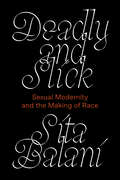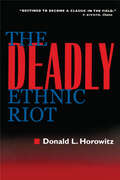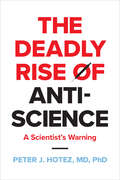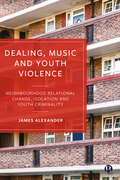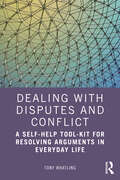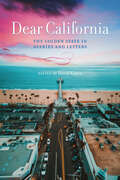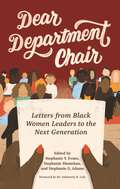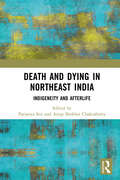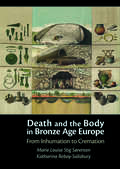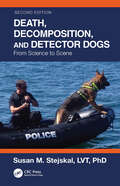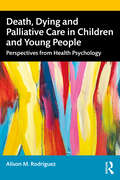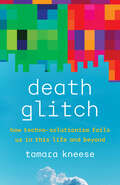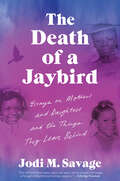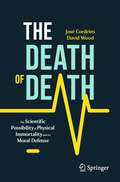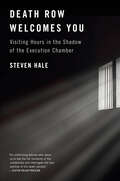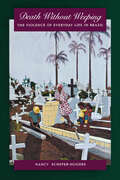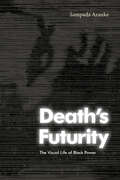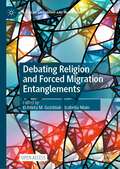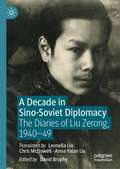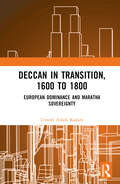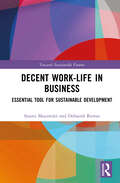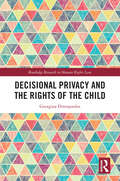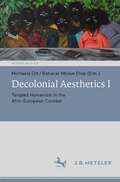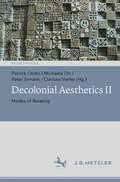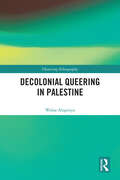- Table View
- List View
Deadly and Slick: Sexual Modernity and the Making of Race
by Sita BalaniA groundbreaking new analysis of the making of modernity, sexuality and raceIf race is increasingly understood to be socially constructed, why does it continue to seem like a physiological reality? The trickery of race, Sita Balani argues, comes down to how it is embedded in everyday life through the domain we take to be most intimate and essential: sexuality. Modernity inaugurates a new political subject made legible as an individual through the nuclear family, sexual adventure and the pursuit of romantic love. By examining the regulation of sexual life at Britain's borders, in colonial India, and through the functioning of the welfare state, marriage laws, education, and counterterrorism, Balani reveals that sexuality has become fatally intertwined with the making of race.
The Deadly Ethnic Riot
by Donald L. HorowitzDonald L. Horowitz's comprehensive consideration of the structure and dynamics of ethnic violence is the first full-scale, comparative study of what the author terms the deadly ethnic riot—an intense, sudden, lethal attack by civilian members of one ethnic group on civilian members of another ethnic group. Serious, frequent, and destabilizing, these events result in large numbers of casualties. Horowitz examines approximately 150 such riots in about fifty countries, mainly in Asia, Africa, and the former Soviet Union, as well as fifty control cases. With its deep and thorough scholarship, incisive analysis, and profound insights, The Deadly Ethnic Riot will become the definitive work on its subject. Furious and sadistic, the riot is nevertheless directed against a precisely specified class of targets and conducted with considerable circumspection. Horowitz scrutinizes target choices, participants and organization, the timing and supporting conditions for the violence, the nature of the events that precede the riot, the prevalence of atrocities during the violence, the location and diffusion of riots, and the aims and effects of riot behavior. He finds that the deadly ethnic riot is a highly patterned but emotional event that tends to occur during times of political uncertainty. He also discusses the crucial role of rumor in triggering riots, the surprisingly limited role of deliberate organization, and the striking lack of remorse exhibited by participants. Horowitz writes clearly and eloquently without compromising the complexity of his subject. With impressive analytical skill, he takes up the important challenge of explaining phenomena that are at once passionate and calculative.
Dealing, Music and Youth Violence: Neighbourhood Relational Change, Isolation and Youth Criminality
by James AlexanderDepending on their dynamics, neighbourhoods may serve to contain or exacerbate youth violence. This book uses fascinating ethnographic and interview data to explore the disappearance of localized relationships in a South London housing estate. Through a comparative analysis of the experiences of different generations, James Alexander considers the impact of both wider socio-economic developments and the gradual move from neighbourly to professional support for young people. As well as evaluating the effectiveness of youth work programmes, he considers how the actions of neighbours and the decisions of policymakers influence how supported young people feel and, consequently, their vulnerability to criminal influences.
Dealing with Disputes and Conflict: A Self-Help Tool-Kit for Resolving Arguments in Everyday Life
by Tony WhatlingDealing with Disputes and Conflict: A Self-Help Tool-Kit for Resolving Arguments in Everyday Life offers accessible and practical strategies and solutions to guide untrained mediators and readers on effective ways to resolve disputes and conflict, across a wide range of dispute contexts. Drawing together psychological and social scientific theories, the author offers clear guidance for managing conflict in everyday life, ranging from experiences at work, with the community or at home. This book defines mediation practice, its key principles, and how it is structured and implemented, and offers practical strategies based on key theories, including Transactional Analysis. Tony Whatling draws on his extensive experience as a professional mediator, consultant, trainer and author, to create this valuable practical guide. Including a toolbox outlining core skills and strategies applied by trained practitioners, the book covers important elements in conflict resolution, such as apology, reconciliation, the importance of listening and concentration, and what to try when disputants do not respond. Case studies from various contexts are featured, giving readers the tools they need when faced with disputes relating to situations such as divorce and workplace disagreements. Exploring the building blocks of dispute management through an engaging and clear tone, this text is ideal for mediators, dispute resolution specialists, volunteers, community leaders, medical staff and anyone embarking on a career in mediation, as well as individuals hoping to resolve conflict in their own lives.
Dear California: The Golden State in Diaries and Letters
by David KipenDispatches from a land of extremes, by writers and movie stars, natives and visitors, activists and pioneers, and more. California has always been, literally, a place to write home about. Renowned figures and iconoclasts; politicians, actors, and artists; the world-famous and the not-so-much—all have contributed their voices to the patchwork of the state. With this book, cultural historian and California scholar David Kipen reveals this long-storied place through its diaries and letters, and gives readers a highly anticipated follow up to his book Dear Los Angeles. Running from January 1 through December 31, leaping across decades and centuries, Dear California reflects on the state's shifting landscapes and the notion of place. Entries talk across the centuries, from indigenous stories told before the Spanish arrived on the Pacific coast through to present-day tweets, blogs, and other ephemera. The collected voices show how far we've wandered—and how far we still have to go in chasing the elusive California dream. This is a book for readers who love California—and for anyone who simply treasures flavorful writing. Weaving together the personal, the insightful, the impressionistic, the lewd, and the hysterically funny, Dear California presents collected writings essential to understanding the diversity, antagonisms, and abiding promise of the Golden State. Writings from Edward Abbey, Louis Armstrong, Ambrose Bierce, Octavia Butler, John Cage, Willa Cather, Cesar Chavez, Julia Child, Winston Churchill, Simone de Beauvoir, Albert Einstein, F. Scott Fitzgerald, Jane Fonda, Allen Ginsberg, Dolores Huerta, Langston Hughes, Zora Neale Hurston, Steve Jobs, Billy Joel, Frida Kahlo, John F. Kennedy, Anne Lamott, John Lennon, Groucho Marx, Henri Matisse, Marshall McLuhan, Herman Melville, Charles Mingus, Marilyn Monroe, John Muir, Ronald Reagan, Sally Ride, Joan Rivers, Susan Sontag, Mark Twain, Oscar Wilde, Laura Ingalls Wilder, Mark Zuckerberg, and many others.
Dear Department Chair: Letters from Black Women Leaders to the Next Generation
by Tiffany Gilbert Sandra Jowers-Barber Carol Henderson Eunice Jeffries Julia S. Jordan-Zachery April C. Langley Tracy Sharpley-Whiting Colette Taylor Regine Jean-Charles Theresa Rajack-Talley Stephanie Adams Stephanie Evans Stephanie Shonekan Janaka LewisPractical and candid, this book offers actionable steps to help Black women leaders create meaningful success. The reflections and recommendations of the contributors forge a critical and transformative analysis of race, gender, and higher education leadership. With insights from humanities, social sciences, art, and STEM, this essential resource helps to redefine the academy to meet the challenges of the future. Dear Department Chair is comprised of personal letters from prominent Black women department chairs, deans, vice provosts, and university presidents, addressed to current and future Black women academic professionals, and offers a rich source of peer mentorship and professional development. These letters emerged from Chair at the Table, a research collective and peer-mentoring network of current and former Black women department chairs at colleges and universities across the U.S. and Canada. The collective’s works, including this volume, serve as tools for faculty interested in administration, current chairs seeking mentorship, and upper-level administrators working to diversify their ranks.
Death and Dying in Northeast India: Indigeneity and Afterlife
by Parjanya Sen Anup Shekhar ChakrabortyThis book formulates a new pedagogy of death with regard to Northeast India and shows how this pedagogy offers an understanding of alternative knowledge systems and epistemes. In documenting a range of customs and practices pertaining to death, dying and the afterlife among the diverse ethnic communities of Northeast India, the book offers new soteriological, epistemological, sociological and phenomenological perspectives on death. Through an examination of these eschatological practices and their anthropological, theological and cultural moorings, the book aims to reach an understanding of notions of indigeneity with regard to Northeast India. The contributors to this book draw upon a range of subjects— from songs, literary texts, monuments, relics and funerary objects to biographies to folktales to stories of spirit possessions and supernatural encounters. It collates the research of scholars primarily from Northeast India, but also from Eastern India and offers an interdisciplinary analysis of these various belief systems and practices. This book will of interest to those researchers and scholars interested in South Asia in general and Northeast India in particular, and also to those interested in the social anthropology of religion, cultural studies, indigenous studies, folklore studies and Himalayan studies.
Death and the Body in Bronze Age Europe: From Inhumation to Cremation
by Marie Louise Sørensen Katharina Rebay-SalisburyThis volume offers new insights into the radical shift in attitudes towards death and the dead body that occurred in temperate Bronze Age Europe. Exploring the introduction and eventual dominance of cremation, Marie-Louise Stig Sørenson and Katharina Rebay-Salisbury apply a case-study approach to investigate how this transformation unfolded within local communities located throughout central to northern Europe. They demonstrate the deep link between the living and the dead body, and propose that the introduction of cremation was a significant ontological challenge to traditional ideas about death. In tracing the responses to this challenge, the authors focus on three fields of action: the treatment of the dead body, the construction of a burial place, and ongoing relationships with the dead body after burial. Interrogating cultural change at its most fundamental level, the authors elucidate the fundamental tension between openness towards the 'new' and the conservative pull of the familiar and traditional.
Death, Decomposition, and Detector Dogs: From Science to Scene
by Susan M. StejskalDeath, Decomposition, and Detector Dogs: From Science to Scene, Second Edition is designed to help canine handlers, detectives, death investigators, crime scene personnel (including forensic laboratory personnel, technicians, and supervisors), and attorneys understand the science involved when utilizing human remains detector (HRD) canines as a locating tool. The book covers the basic anatomy and physiology of canine olfaction and the unique characteristics of their scenting ability that allows dogs to be trained to locate distinct odors. Using concise and clear explanations and photographs, the book reviews the science of forensic taphonomy. Factors that may affect the decomposition process are highlighted along with what the potential outcomes that may be encountered. The book examines how the odor of human remains is generated through various stages of decomposition and the manner in which environmental conditions in both land and water settings may affect that odor. Different types of background information that may help in determining possible search locations for missing individuals are included as well as assist the HRD canine handler in developing search plans are covered. Different tools and technologies that may be used in addition to an HRD canine team are included to help readers understand that are many ways to address searching for a decedent. Several case reports involving decedents, found in both land and water settings in addition to different weather conditions, are included to help the reader understand how the environment may have affected the condition of the decedent. This edition includes more case reports explaining how environmental factors were considered in HRD canine deployments in both land and water settings. Understanding which variables—and how such variables—can affect the state and condition of human remains, as well as dispersion of odor from human remains, will help canine handlers utilize their HRD canine more effectively as a locating tool. Death, Decomposition, and Detector Dogs, Second Edition will help HRD canine handlers and other law enforcement personnel be better prepared to meet the challenges of their jobs before, during, and after searches for the missing.
Death, Dying and Palliative Care in Children and Young People: Perspectives from Health Psychology
by Alison M. RodriguezDeath, Dying and Palliative Care in Children and Young People: Perspectives from Health Psychology examines the issues relevant to children and young people living with serious illness and their families by taking a closer look at the literature and knowledge around the processes of care, health, well-being and development through a health psychology lens. The text introduces readers to the general palliative and holistic care needs of children and young people along with the nuances of caring relationships. The chapters discuss the vulnerabilities encountered in living with serious illness and facing a shortened life prognosis, being at the end of life, and issues relative to the historical concept of the ‘good death’ or ‘dying well’, grief, and bereavement. The author examines how individual and familial experiences can be multi-layered, which can consequently influence perceptions and behaviours. The text therefore offers a deep exploration of the varied ways in which people draw on different resources to navigate their palliative care lived experiences. The book will be beneficial to the students of, and individuals interested in, psychology and nursing along with other health and social care courses. It will further be of interest to individuals interested in gaining more understanding of the experiential aspects of death, dying and palliative care in children and young people from health psychology perspectives.
Death Glitch: How Techno-Solutionism Fails Us in This Life and Beyond
by Tamara KneeseAn accessible yet erudite deep dive into how platforms are remaking experiences of death Since the internet&’s earliest days, people have died and mourned online. In quiet corners of past iterations of the web, the dead linger. But attempts at preserving the data of the dead are often ill-fated, for websites and devices decay and die, just as people do. Death disrupts technologists&’ plans for platforms. It reveals how digital production is always collaborative, undermining the entrepreneurial platform economy and highlighting the flaws of techno-solutionism. Big Tech has authority not only over people&’s lives but over their experiences of death as well. Ordinary users and workers, though, advocate for changes to tech companies&’ policies around death. Drawing on internet histories along with interviews with founders of digital afterlife startups, caretakers of illness blogs, and transhumanist tinkerers, the technology scholar Tamara Kneese takes readers on a vibrant tour of the ways that platforms and people work together to care for digital remains. What happens when commercial platforms encounter the messiness of mortality?
The Death of a Jaybird: Essays on Mothers and Daughters and the Things They Leave Behind
by Jodi M. SavageReminiscent of The Year of Magical Thinking and Somebody’s Daughter, a deeply empathetic and often humorous collection of essays that explore the author’s ever-changing relationships with her grandmother and mother, through sickness and health, as they experience the joys and challenges of Black American womanhood.Jodi M. Savage was raised in Brooklyn, New York, by her maternal grandmother. Her whip-smart, charismatic mother struggled with addiction and was unable to care for her. Granny—a fiery Pentecostal preacher who had a way with words—was Jodi’s rock, until Alzheimer’s disease turned the tables, and a 28-year-old Jodi stepped into the role of caretaker. It was up to Jodi to get them both through the devastations of a deteriorating mind. After Granny passed away, Jodi spent years trying to reckon with her grief. Jodi and her mother were both diagnosed with breast cancer nearly a decade later, and then Jodi lost her too.In this searing, candid collection of essays, Jodi illuminates the roles that identity and memory play in preserving those we love. Jodi explores the lives of modern Black women and communities through the prism of her personal experiences. With grace, creativity, and insight, she looks at femininity, family, race, mental illness, grief, healthcare, and faith. Jodi deftly portrays how trauma is inherited, and how the struggle to break a generational curse can last a lifetime.The Death of a Jaybird is a thoughtful examination of complicated family love, loss, and the liberating power of claiming our stories.
The Death of Death: The Scientific Possibility of Physical Immortality and its Moral Defense (Copernicus Books)
by José Cordeiro David WoodIs death inevitable? Until now, the history of mankind has been marked by this fatal fact. Religions, borders and progress are born from an ancient fear of death, comfort from this fear man often found only in religious paradigms. But according to José Luis Cordeiro and David Wood, the incontrovertible fact of death is no longer an absolute certainty - science and technology are preparing to tear down the final frontier: that of immortality.This accessible book provides insight into recent exponential advances in artificial intelligence, tissue regeneration, stem cell treatment, organ printing, cryopreservation, and genetic therapies that, for the first time in human history, offer a realistic chance to solve the problem of the aging of the human body. In this book, Cordeiro and Wood not only present all the major developments, initiatives, and ideas for eternal life, they also show why there are a number of good arguments for seeing death for what it is: the last undefeated disease.Enter any drugstore or bookstore, and we confronted with a mountain of nonsense concerning the aging process. Society seems obsessed with aging. That is why The Death of Death is such a refreshing delight, able to cut through the hype and reveal a balanced, authoritative, and lucid discussion of this controversial topic. It summarizes the astonishing breakthroughs made recently in revealing how science may one day conquer the aging process.Michio Kaku, theoretical physicist and author of The God Equation: The Quest for a Theory of Everything We are entering a Fantastic Voyage into life extension, crossing different bridges that will take us to indefinite life spans. The Death of Death explains clearly how we might soon reach longevity escape velocity and live long enough to live forever. Ray Kurzweil, co-author of Fantastic Voyage: Live Long Enough to Live Forever and co-founder of Singularity University The Death of Death is a truly revolutionary book. This is a visionary book that confronts us with the terrible reality of aging, and its authors are friends and connoisseurs of the subject. I believe that the authoritative and exhaustive description of this crusade that José and David make in this excellent book will accelerate this process. Forward! Aubrey de Grey, founder of LEV (Longevity Escape Velocity) Foundation and co-author of Ending Aging
Death Row Welcomes You: Visiting Hours in the Shadow of the Execution Chamber
by Steven HaleIn the vein of Waiting for an Echo and Dead Man Walking, a deeply immersive look at justice in America, told through the interwoven lives of condemned prisoners and the men and women who come to visit them . . .In 2018, after nearly a decade&’s hiatus, the state of Tennessee began executing death row inmates, bucking national trends that showed the death penalty in decline. In less than two years, the state put seven men to death, more than any other state but Texas in that time period. It was an execution spree unlike any seen in Tennessee since the 1940s, one only brought to a halt by a global pandemic. Award-winning journalist Steven Hale was the leading reporter on these executions, covering them both locally for the Nashville Scene alt-weekly and nationally for The Appeal.In Death Row Welcomes You, Hale traces the lives of condemned prisoners at the Riverbend Maximum Security Institution—and the people who come to visit them. What brought them—the visitors and convicted murderers alike—to death row?The visitors are, for the most part, not activists—or at least they did not start out that way. Nor are they the sort of killer-obsessed death row groupies such settings sometimes attract. In fact, in most cases they are average people whose lives, not to mention their views on the death penalty, were turned upside down by a face-to-face meeting with a death row prisoner.Hale&’s access to the people that make up that community afforded him a perspective that no other journalist has been granted, largely because Tennessee&’s Department of Correction has all but shut off official media access.Combining topics that have long fascinated readers—crime, death, and life inside prison—Hale writes with humanity, empathy, and insight earned by befriending death row prisoners . . . and standing witness to their final moments.
Death Without Weeping: The Violence of Everyday Life in Brazil
by Nancy Scheper-HughesWhen lives are dominated by hunger, what becomes of love? When assaulted by daily acts of violence and untimely death, what happens to trust? Set in the lands of Northeast Brazil, this is an account of the everyday experience of scarcity, sickness and death that centres on the lives of the women and children of a hillside "favela". Bringing her readers to the impoverished slopes above the modern plantation town of Bom Jesus de Mata, where she has worked on and off for 25 years, Nancy Scheper-Hughes follows three generations of shantytown women as they struggle to survive through hard work, cunning and triage. It is a story of class relations told at the most basic level of bodies, emotions, desires and needs. Most disturbing - and controversial - is her finding that mother love, as conventionally understood, is something of a bourgeois myth, a luxury for those who can reasonably expect, as these women cannot, that their infants will live.
Death's Futurity: The Visual Life of Black Power (The Visual Arts of Africa and its Diasporas)
by Sampada ArankeIn Death’s Futurity Sampada Aranke examines the importance of representations of death to Black liberation. Aranke analyzes posters, photographs, journalism, and films that focus on the murders of Black Panther Party members Lil’ Bobby Hutton, Fred Hampton, and George Jackson to construct a visual history of the 1960s and 1970s Black Power era. She shows how Black radicals used these murders to engage in political action that imagined Black futurity from the position of death. Photographs of Hutton that appeared on flyers and posters called attention to the condition of his death while the 1971 documentary The Murder of Fred Hampton enabled the consideration of Hampton’s afterlife through visual meditations on his murder. Printmaking and political posters surrounding Jackson’s murder marked the transition from Black Power to the prison abolition movement in ways that highlighted the relationship between surveillance, policing, incarceration, and anti-Black violence. By foregrounding the photographed, collaged, filmed, and drawn Black body, Aranke demonstrates that corporeality and corpses are crucial to the efforts to shape visions of a Black future free from white supremacy.
Debating Religion and Forced Migration Entanglements (Politics of Citizenship and Migration)
by Elżbieta M. Goździak Izabella MainThis open access book brings into dialogue emerging and seasoned migration and religion scholars with spiritual leaders and representatives of faith-based organizations assisting refugees. Violent conflicts, social unrest, and other humanitarian crises around the world have led to growing numbers of people seeking refuge both in the North and in the South. Migrating and seeking refuge have always been part and parcel of spiritual development. However, the current 'refugee crisis' in Europe and elsewhere in the world has brought to the fore fervent discussions regarding the role of religion in defining difference, linking the ‘refugee crisis’ with Islam, and fear of the ‘Other.’ Many religious institutions, spiritual leaders, and politicians invoke religious values and call for strict border controls to resolve the ‘refugee crisis.’ However, equally many humanitarian organizations and refugee advocates use religious values to inform their call to action to welcome refugees and migrants, provide them with assistance, and facilitate integration processes. This book includes three distinct but inter-related parts focusing, respectively, on politics, values, and discourses mobilized by religious beliefs; lived experiences of religion, with a particular emphasis on identity and belonging among various refugee groups; and faith and faith actors and their responses to forced migration.
A Decade in Sino-Soviet Diplomacy: The Diaries of Liu Zerong, 1940–49
by David BrophyThis book will illuminate Xinjiang studies as never before, publishing for the first time the complete diaries of Liu Zerong, governor of Xinjiang during World War II, illuminating the origin of contemporary policies for smaller ethnic groups in the new China that emerged in 1949. The diaries are introduced with a biographical study of Liu, and a discussion of the historical context of World War II and the post-war situation in Xinjiang, which was divided into rival spheres of KMT control, and the Soviet-aligned East Turkistan Republic. Both in the Moscow embassy, and in the provincial administration of Ürümchi, Liu Zerong was Republican China’s chief Russian-speaking representative, whose task it was to engage on a daily basis with his Soviet counterparts. His extensive diaries therefore offer a unique insight into this tense decade of Sino-Soviet diplomacy, and will be of interest to a wide range of scholars in fields of Chinese and international history. The accompanying set of essays by the world's leading Xinjiang scholars confirm this volume's status as a key text for scholars, policymakers and others seeking to understand Chinese policies in Xinjiang.
Deccan in Transition, 1600 to 1800: European Dominance and Maratha Sovereignty
by Umesh Ashok KadamThis book presents the socio-cultural and historical trajectories of the Deccan plateau as well as the coastal areas of the current states of Andhra Pradesh, Maharashtra, Karnataka and Goa. It studies the art of diplomacy by discussing the diplomatic relations between the Marathas and various European companies, as well as the indigenous regional states. The author also probes into the Maratha naval policy, the evolution of a composite Deccani culture and the cultural flux that was taking place within the Maratha country. Through an interdisciplinary lens, the volume examines how caste and gender relations operated, how the idea of dissent was generated as well as the socio-political impact of various linguistic, ethnic and religious groups. Through a study of monuments, sculpture and paintings prevalent in the region, the book also discusses the developments in art and architecture in the Deccan. Rich in archival sources, this book is a must read for scholars and researchers of Indian history, colonial history, South Asian history, Maratha history and history in general.
Decent Work-Life in Business: Essential Tool for Sustainable Development (Towards Sustainable Futures)
by Soumi Majumder Debasish BiswasDecent Work-Life in Business: Essential Tool for Sustainable Development presents a detailed discussion of the concept of decent work-life and its application in business for sustainable development. It discusses decent work-life culture in a business environment. The book makes a strong case for decent work, which not only provides work opportunities but also delivers a fair income, fair treatment, security at the workplace, and social protection for families. With the help of empirical data and statistical indicators, it explores themes such as: ILO and decent work agenda opportunities for work and dignity at work social dimensions of globalization and sustainable development poverty reduction through decent work work-life balance and social protection unacceptable work and social dialogue economic and social context of decent work This book will be an indispensable resource for the students, scholars and teachers of business management and especially those pursuing a career in human resource management. It will also interest scholars of political economy, sociology of work, business management, human resource management, labour studies, public policy, and social anthropology alongside industry experts.
Decisional Privacy and the Rights of the Child (Routledge Research in Human Rights Law)
by Georgina DimopoulosDecisional privacy gives individuals the freedom to act and make decisions about how they live their lives, without unjustifiable interference from other individuals or the state. This book advances a theory of a child’s right to decisional privacy. It draws on the framework of the United Nations Convention on the Rights of the Child and extends the work of respected children’s rights scholars to address a significant gap in understanding the interconnections between privacy, family law and children’s rights. It contextualises the theory through a case study: judicial proceedings concerning medical treatment for children experiencing gender dysphoria. This work argues that recognising a substantive right to decisional privacy for children requires procedural rights that facilitate children’s meaningful participation in decision-making about their best interests. It also argues that, as courts have increasingly encroached upon decision-making regarding children’s medical treatment, they have denied the decisional privacy rights of transgender and gender diverse children. This book will benefit researchers, students, judicial officers and practitioners in various jurisdictions worldwide grappling with the tensions between children’s rights, parental responsibilities and state duties in relation to children’s best interests, and with the challenge of better enabling and listening to children’s voices in decision-making processes.
Decolonial Aesthetics I: Tangled Humanism in the Afro-European Context (Ästhetiken X.0 – Zeitgenössische Konturen ästhetischen Denkens)
by Michaela Ott Babacar Mbaye DiopThe publication aims to make suggestions for a 'decolonisation of aesthetics' within an Afro-European framework. The texts (whose authors come from different cultural contexts between Germany, France, Senegal, Benin, Nigeria and Tunesia) do not only refer to heterogenous aesthetic practices understood as subversive and decolonial strategies, but also discuss philosophical questions of a renewed (non-in)dividual humanism. The artistic practices analyzed include artistic installations and ensembles as well as actions in urban and rural space, deceptive manœuvres at the borders and their photographic documentation, and many more.
Decolonial Aesthetics II: Modes of Relating (Ästhetiken X.0 – Zeitgenössische Konturen ästhetischen Denkens)
by Patrick Oloko Michaela Ott Peter Simatei Clarissa VierkeThis book features writing by 17 authors from Germany and from African and Latin American countries on highly diverse aesthetic phenomena as seen from their own different points of view. The texts in this volume all deal with the imperative of ‘decolonization’: they try to highlight aesthetic strategies for the (re)discovery of unthematized, misappropriated, transcultural and even transcontinental histories and memories and aesthetic practices that are absent from or too little perceived within national consciousnesses. Novels, poems and musical performances from the East African region are analysed as intertwined histories of the Indian Ocean and its different languages. Artworks of the Black Atlantic and perceptions of Africa are discussed from, for example, Brazilian perspectives. Within the German context, decolonisation strategies in exhibition practices in ethnological or art museums developed by Nigerian artists are evaluated; new terms such as ‘dividuation’ are proposed to describe these contemporary composite-cultural entanglements, and so on. A stimulating, wide-ranging and heterogeneous portrait of contemporary interwoven world cultures!
Decolonial Queering in Palestine (Theorizing Ethnography)
by Walaa AlqaisiyaThis book provides a vivid account of the political valence of weaving queer into native positionality and the struggle for decolonisation in the settler colonial context of Palestine, referred to as decolonial queering. It discusses how processes of gender and sexuality that privilege hetero-colonising authority shaped and continue to define both the Israeli-Zionist conquest of Palestine and the Palestinian struggle for liberation, thus future imaginings of free Palestine. This account emerges directly from the voices and experiences of Palestinian activists and artists; particularly, it draws on fieldwork with Palestine’s most established queer grassroots movement alQaws for Sexual and Gender Diversity in Palestinian Society and a variety of artistic Palestinian productions (photography, fashion, music, performance, and video art). Offering a comprehensive and in-depth engagement with the situated context, history, and local practices of Palestinian queerness, scholars, students, and activists across (de)colonial, race and gender/sexuality studies would appreciate its unique insights, its empirical focus also reaches to those academics in the wider fields of Middle Eastern, anthropological, and political studies.
